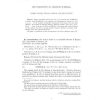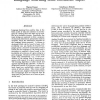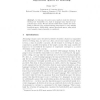MEMICS
2010
14 years 12 days ago
2010
Identification in the limit, originally due to Gold [10], is a widely used computation model for inductive inference and human language acquisition. We consider a nonconstructive ...
COLT
2010
Springer
14 years 3 months ago
2010
Springer
In learning, a semantic or behavioral U-shape occurs when a learner rst learns, then unlearns, and, nally, relearns, some target concept (on the way to success). Within the framew...
TCS
2010
14 years 4 months ago
2010
In the inductive inference framework of learning in the limit, a variation of the bounded example memory (Bem) language learning model is considered. Intuitively, the new model co...
ECCC
2008
14 years 5 months ago
2008
Higman essentially showed that if A is any language then SUBSEQ(A) is regular, where SUBSEQ(A) is the language of all subsequences of strings in A. Let s1, s2, s3, . . . be the sta...
COLT
1992
Springer
14 years 9 months ago
1992
Springer
Language learning from positive data in the Gold model of inductive inference is investigated in a setting where the data can be modeled as a stochastic process. Specifically, the...
CIE
2007
Springer
14 years 11 months ago
2007
Springer
In the standard model of inductive inference, a learner gets as input the graph of a function, and has to discover (in the limit) a program for the function. In this paper, we cons...
LATA
2009
Springer
15 years 12 days ago
2009
Springer
In this paper we survey some results in inductive inference showing how learnability of a class of languages may depend on hypothesis space chosen. We also discuss results which co...
ALT
2001
Springer
15 years 2 months ago
2001
Springer
The present work is dedicated to the study of modes of data-presentation in the range between text and informant within the framework of inductive inference. In this study, the le...




